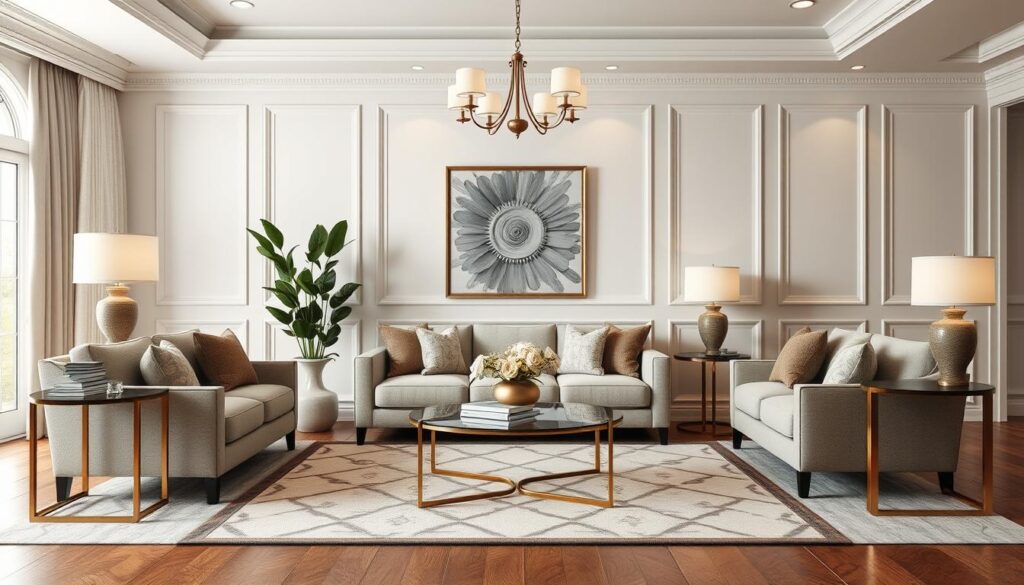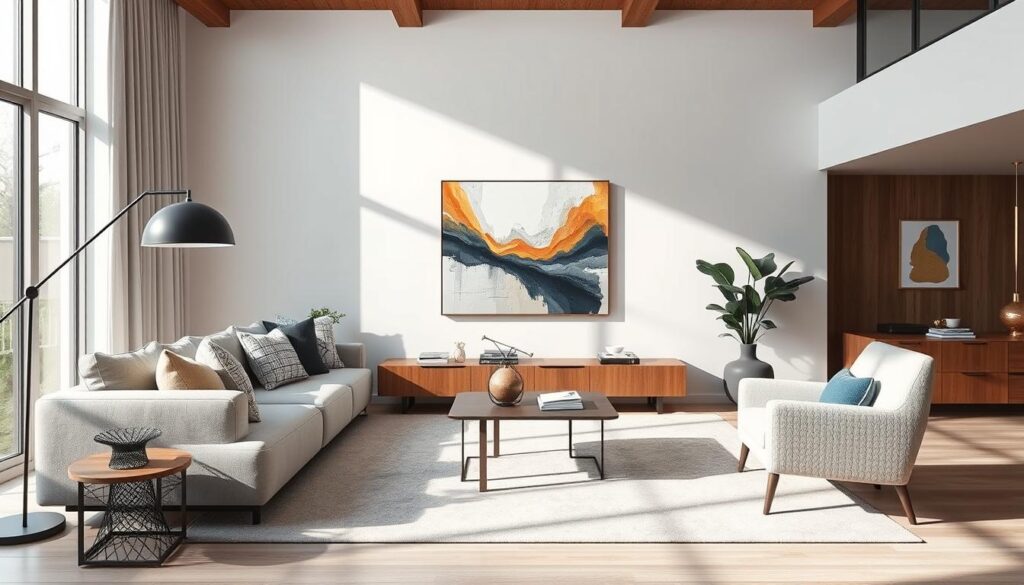Symmetry is key in interior design, making spaces look better and feel more balanced. It’s seen in big homes and small apartments alike. By using symmetry, a room can turn into a work of art.
This article explores the role of symmetry in home design. We’ll look at its different types, why it’s important, and how to use it in your home. Whether you love design, want to improve your home, or are a pro decorator, you’ll find useful tips here. We aim to help you create spaces that are both beautiful and harmonious.
Key Takeaways
- Symmetry in home design creates a sense of balance and visual harmony
- Exploring the different types of symmetry, including formal, informal, and radial, can help you identify the best approach for your space
- Understanding why symmetry matters, from its psychological impact to its ability to enhance the perception of luxury and sophistication
- Strategies for incorporating symmetrical layouts, furniture arrangement, and architectural features to achieve a cohesive, visually appealing interior
- Blending symmetry with personal style to create a unique and captivating living environment
The Power of Symmetry in Home Design
Symmetry is a key design principle that can change a room. It brings order, balance, and harmony. By arranging elements symmetrically, you can create a sophisticated look that catches the eye and brings calm.
The role of symmetry in home design is huge. It can improve the balance and look of a space, making it more inviting. It also adds stability and structure, great for big or open-plan rooms.
Moreover, symmetry’s benefits go beyond looks. It can make a room feel more organized and neat. This is great for those who like their homes tidy and efficient.
“Symmetry is a fundamental design principle that can have a profound impact on the overall feel and functionality of a space.”
Adding symmetry to your home design can transform any room. It’s perfect for cozy living rooms, peaceful bedrooms, or grand entryways. By understanding symmetry’s power, you can make your home more beautiful and harmonious.
Defining Symmetry in Interior Design
In interior design, symmetry means arranging elements so one side mirrors the other. This balance is key to creating harmony and proportion in a room. Knowing what symmetry is helps designers improve a space’s look and feel.
Types of Symmetry
There are different types of symmetry in home decor:
- Bilateral Symmetry – This is when the left and right sides of a space are exact mirrors.
- Radial Symmetry – Elements are arranged in a circle, with a central point as the axis.
- Translational Symmetry – Patterns or motifs are repeated, creating a flow across a surface.
Why Symmetry Matters
Symmetry is very important in interior design. It creates a balanced look that makes a space feel stable and ordered. This balance improves a room’s aesthetic appeal, making it feel cohesive and inviting.
Using symmetry also changes how we see a room’s size and shape. It can make a room seem larger and more open.

“Symmetry is the foundation of balance, and balance is the foundation of good design.” – Unknown
Symmetrical Layouts: Creating Harmony
Interior design uses symmetrical layouts to bring balance and harmony to a space. By placing furniture and decor in a mirrored way, designers create a cohesive look. This look is both beautiful and calming.
Symmetrical layouts often have a central point, like a fireplace. Furniture and decor are then arranged around it in a balanced way. This works well in living rooms, dining rooms, and entryways to make them welcoming.
Using symmetrical design layouts is another way to add symmetry. This involves placing windows and lights in a mirrored fashion. It makes a space feel more balanced and visually appealing.

When designing with symmetry, finding the right balance is key. Too much symmetry can feel stiff, while too little can lack cohesion. The goal is to use symmetry to enhance the look while still allowing for personal touch.
| Benefits of Symmetrical Layouts | Considerations for Symmetrical Layouts |
|---|---|
|
|
Using symmetrical layouts and design elements can make spaces look great and feel balanced. Whether it’s furniture, architectural features, or decor, symmetry is a powerful tool. It helps achieve the desired look in any interior design project.
Asymmetrical Designs: Embracing Contrast
While symmetry is common in home design, asymmetrical design offers a unique look. It brings a modern, dynamic feel to any space. Asymmetrical interiors have elements that are intentionally off-kilter. This creates a bold, captivating look that breaks away from traditional balance.
Balancing Asymmetry
To make asymmetrical design in home decor work, balance is key. Mixing asymmetrical and symmetrical elements creates a space that’s both modern and well-put-together. This blend makes the space visually appealing and harmonious.
- Use symmetrical pieces, like matching lamps or artwork, to ground the space. This prevents it from feeling disjointed.
- Geometric patterns, repetitive shapes, or mirrored arrangements add order and balance to an asymmetrical layout.
- Keep a consistent color and material palette. This unifies the asymmetrical design and gives it a cohesive, intentional look.
By balancing asymmetry in interiors, you can make a space that’s both captivating and welcoming. It challenges traditional design while feeling harmonious.

“Asymmetry isn’t about chaos; it’s about creating a sense of visual interest and surprise. When done right, it can elevate a space to new levels of sophistication and personality.”
The Role of Symmetry in Furniture Arrangement
Symmetry is key in furniture arrangement, making spaces look cohesive and appealing. By placing sofas and chairs symmetrically, designers create focal points. This guides the eye, making the space balanced and harmonious.
Focal Points and Symmetrical Placement
In symmetrical rooms, furniture placement is crucial for balance and interest. Designers often center a focal point like a fireplace or artwork. Furniture is then arranged symmetrically around it, enhancing the design and drawing the eye to key points.
For example, a classic living room might have a sofa centered on the fireplace. Two matching chairs are placed on either side. This arrangement brings order and harmony, with the fireplace as the focal point.

In dining rooms, a symmetrical furniture placement around a central table creates a balanced design. This arrangement not only looks good but also defines the room’s purpose and function.
| Symmetry in Furniture Placement | Asymmetrical Furniture Arrangement |
|---|---|
|
|
Understanding the role of symmetry in furniture placement helps designers create inviting spaces. These spaces reflect the homeowner’s style and preferences, making the interior visually captivating.
Symmetry in Architectural Features
Symmetry in home design is more than just looks. It brings balance, order, and timeless elegance. This is true for architectural features like fireplaces, windows, and entryways.
Adding symmetrical architectural elements in home design changes a space’s look and feel. Designers align key features for a harmonious and pleasing outcome. This creates a calm and serene atmosphere.
A symmetrical fireplace is a striking example. It has flanking shelves or cabinetry, making it a room’s focal point. This design turns a dull living space into a balanced and striking room.
Windows arranged symmetrically add harmony and sophistication to a home’s exterior. By aligning windows, architects create a visual rhythm. This enhances the symmetry in architectural design.
Entryways also benefit from symmetry. A symmetrical front door, with matching sidelights or columns, welcomes visitors. It sets a positive tone for the home.
“Symmetry is one of the most powerful design tools at our disposal, and when used judiciously, it can transform a space from ordinary to extraordinary.”
Using symmetrical architectural elements in home design unlocks a space’s potential. It brings balance, elegance, and timeless appeal.

Incorporating Symmetry in Decor
Symmetry is more than just the layout or architecture of a space. It’s also about the decorative elements that make a room complete. From artwork to lighting and accessories, using symmetrical patterns and reflections can make any room look better.
Mirrors and Symmetrical Reflections
Mirrors are great for adding symmetry to your home. By placing them right, you can make the room look bigger and more balanced. Whether it’s a big mirror or a set of smaller ones, they can create a beautiful symmetrical look.

Other symmetrical elements include matching vases, candles, or sculptures. You can also arrange lighting in a symmetrical way. This adds balance and interest to your space.
Using symmetrical decor elements and mirrors for symmetry in home design can really change a room. It makes the space look harmonious and visually appealing. It’s a way to make your room stand out and feel more relaxing.
Blending Symmetry and Personality
Mixing symmetry with personal style is key to a unique home. Symmetry brings order, but adding asymmetrical elements and unique textures makes a space special. This mix brings out individuality and character.
By incorporating symmetry into unique home design, you can find a balance. This balance lets you create spaces that look good and show off your style.
Think about placing mirrors, artwork, and furniture to make symmetrical points. Then, add asymmetrical touches like:
- Uniquely shaped light fixtures
- Textured throw pillows or rugs
- Eclectic mix of decor items
This mix creates a space that’s both beautiful and personal. It invites you to make it your own.
“Striking the right balance between symmetry and individuality is the hallmark of exceptional interior design.”

By carefully balancing symmetry with personal style, you make a space that looks great and feels like home. This way of incorporating symmetry into unique home design brings together order and self-expression. It makes your home truly special.
Symmetry in Outdoor Living Spaces
Creating visually appealing outdoor spaces involves symmetry. Homeowners can use symmetrical landscaping to make patios, gardens, and oases peaceful. These spaces reflect the balance found in nature.
Symmetrical Landscaping
Symmetry in outdoor design uses various techniques. Parallel pathways, mirrored planters, and balanced water features are examples. These elements make outdoor spaces look good and feel welcoming.
- Parallel pathways leading to a central focal point
- Symmetrically placed planters or garden beds
- Mirrored water features, such as fountains or reflecting pools
- Balanced placement of trees, shrubs, and other landscaping elements
By arranging these symmetrical landscaping elements carefully, homeowners achieve balance. This balance makes outdoor spaces visually appealing and peaceful. It invites people to relax and enjoy the surroundings.

“Symmetry in landscape design can be a powerful tool for creating a sense of balance and order, which can be particularly soothing and calming to the eye and mind.”
Integrating symmetry in outdoor design helps homeowners create a beautiful space. This space blends well with the natural world around it.
Conclusion
Symmetry in home design is truly powerful. It brings balance, harmony, and beauty to our living spaces. By using symmetry, we can make our homes more appealing and welcoming.
Using symmetry in interiors is key. Symmetrical layouts create order and unity. Asymmetrical designs, on the other hand, add depth and personality. This applies to both indoor and outdoor spaces.
Whether you like classic symmetry or modern asymmetry, symmetry is essential. It helps create a stunning and harmonious home. By mastering symmetry, your home becomes a sanctuary of balance and beauty.

